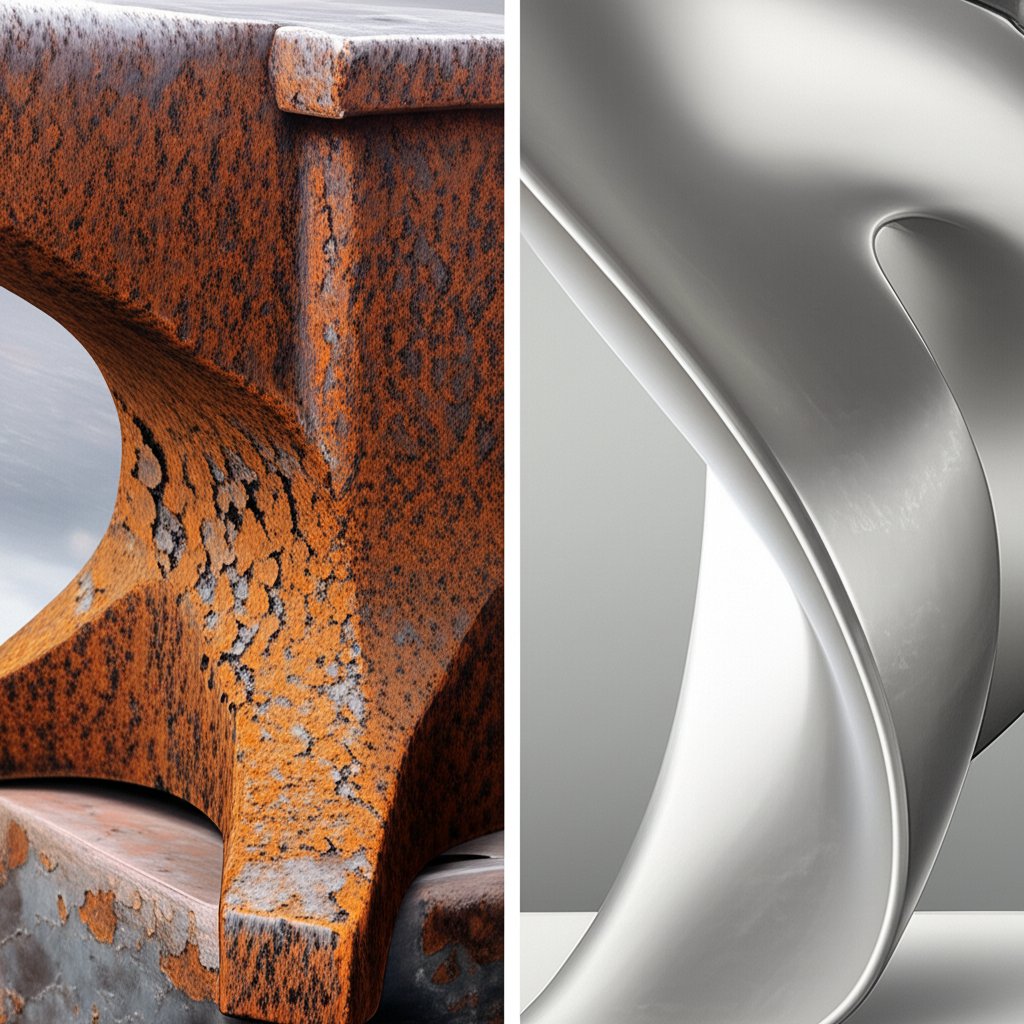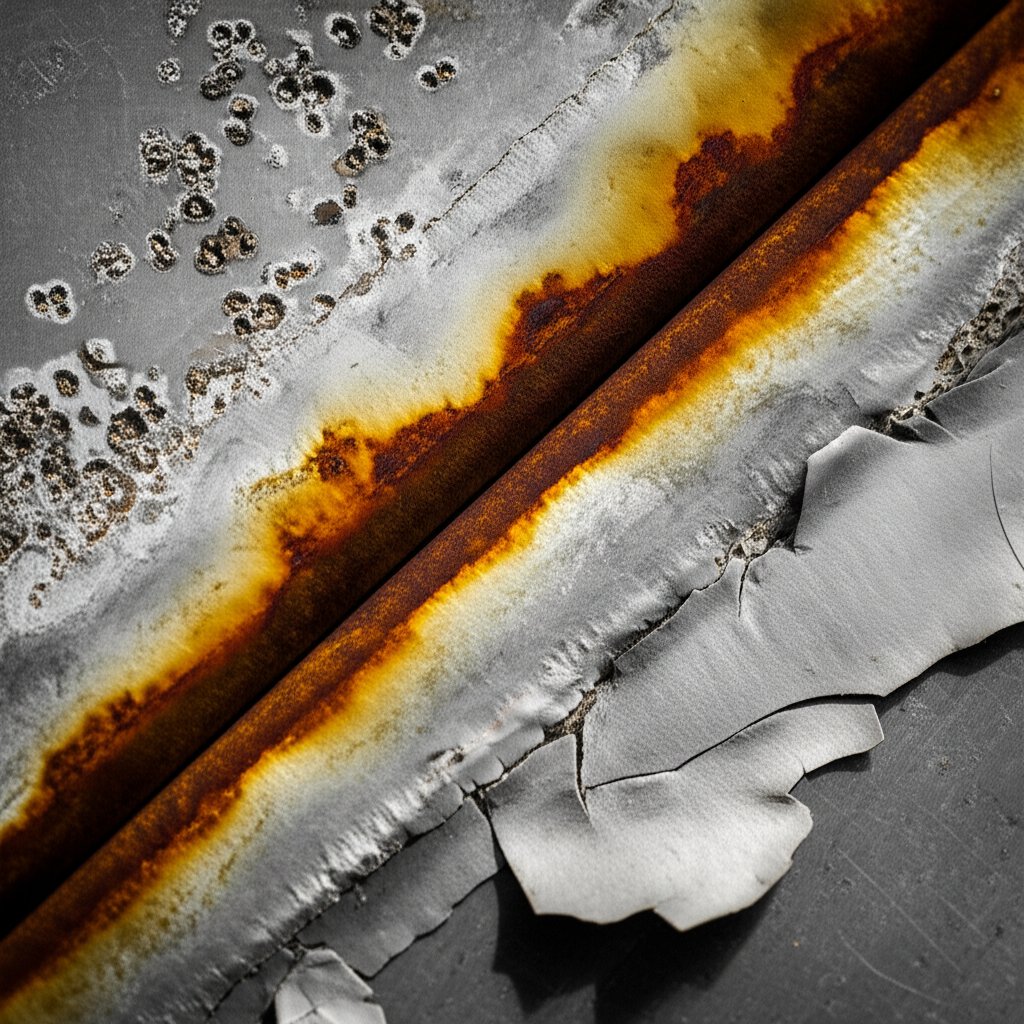
Have you ever wondered, "Does aluminum rust?" If you’ve seen a weathered aluminum patio chair or an old window frame, you might have noticed they don’t flake apart like rusty iron. That’s because aluminum doesn’t rust in the traditional sense—so what really happens to aluminum over time?
Aluminum does not rust, but it undergoes a process called oxidation, forming a protective layer.
To understand this, let’s break down the difference between corrosion vs rust. Rust is a specific type of corrosion that only affects iron and its alloys (like steel). When iron reacts with oxygen and moisture, it forms iron oxide—better known as rust—which is reddish-brown, flaky, and keeps eating away at the metal beneath. This is why iron structures can weaken and crumble if left unprotected.
Aluminum, on the other hand, reacts differently. When exposed to air, it quickly forms a thin, invisible layer of aluminum oxide on its surface. This layer acts like armor, shielding the underlying metal from further attack by air or water. So, while you may hear people ask, “Will aluminum rust?” or “Can aluminum rust?,” the answer is no—aluminum and rust simply don’t go together. Instead, aluminum undergoes a unique form of corrosion that actually protects it.
Curious why doesn't aluminum rust the way iron does? The answer lies in the chemistry of aluminum oxide, which we’ll explore in more detail next. Understanding this difference is key to knowing why aluminum is such a popular, long-lasting material for everything from building facades to car parts.

Sounds complex? Let’s break it down. When iron or steel is left exposed to air and moisture, a familiar reddish-brown layer forms—this is rust, or iron oxide. The process begins when iron atoms react with oxygen and water in a chemical reaction that strips away electrons from the metal. This is a classic example of oxidation, which is just one type of corrosion. But what causes corrosion to become so destructive in iron?
Over time, this cycle can destroy iron structures completely, as the protective layer never truly forms. That’s why rusty bridges, old fences, and forgotten tools can eventually crumble away. The continuous breakdown is a major reason why rust is so damaging—and why the phrase corrosion vs rust often comes up when comparing different metals.
Now, imagine what happens when aluminum is exposed to air. Does aluminum oxidize? Absolutely—but the result is very different. Instead of a flaky, weak layer, aluminum immediately develops a thin, tightly-bonded film of aluminium oxide on its surface, sometimes called a ‘patina’.
Think of it as nature’s own shield: while iron’s rust peels away and exposes new metal, the oxidation on aluminium actually locks in protection. This is why you rarely see aluminum objects deteriorate in the same dramatic way as iron. Instead, the surface may appear duller or slightly gray over time—a sign of oxidized metal that’s still structurally sound underneath.
So, why doesn’t aluminum rust like iron? It all comes down to the chemistry of the protective oxide layer. This difference is what makes aluminum such a valuable material for everything from airplanes and cars to windows and outdoor furniture. Understanding the science behind aluminum oxidation helps explain its unique durability—and why, when it comes to corrosion, not all metals are created equal.
Next, let’s explore how this remarkable oxide layer works as a natural defense, and what it means for the everyday use of aluminum products.
When you leave a piece of aluminum outside, have you ever noticed how it doesn’t develop the reddish flakes you see on old iron railings? Instead, it might lose its shine and develop a dull, grayish surface. This isn’t a sign of weakness—in fact, it’s aluminum’s secret weapon in the fight against corrosion.
Here’s what happens: The moment aluminum is exposed to air or moisture, it reacts with oxygen to form a thin, invisible layer of aluminum oxide. This process, called passivation, happens almost instantly. Unlike rust on iron, which keeps eating away at the metal, the aluminum oxide layer clings tightly to the surface, sealing it off from further attack. This is why, when you hear the question, “Does aluminium rust?,” the answer always comes back to this unique self-protective process.
So, what does aluminum corrosion look like? Instead of flaking or crumbling, oxidized aluminum usually appears as a matte, gray, or sometimes slightly white coating. If you compare a piece of polished aluminum to one left outside for a few months, you’ll notice this difference right away. The surface may lose its mirror-like gleam, but the metal beneath remains strong and intact.
This remarkable property is a major fact about aluminum and explains why it’s used in everything from window frames to airplanes. The oxide layer not only protects the metal but also means that aluminum is among the best answers to the question, what metal does not rust?
But does aluminum tarnish? Yes, in a way—the dull finish you see is a form of tarnish, but unlike silver or copper, it’s actually beneficial. And is aluminum brittle? Not at all—the oxide layer is hard, but the underlying metal remains flexible and tough, so your aluminum parts won’t snap or crumble from normal use.
Curious to learn more or see real-world examples? Check out this in-depth guide on what makes aluminum so corrosion-resistant.
Understanding how aluminum creates its own armor helps explain its popularity in demanding environments. Next, we’ll look at what happens when this protective shield is compromised and when “good” corrosion can turn destructive.

Imagine leaving your aluminum patio furniture near the ocean, only to discover tiny, scattered pits or pinholes on its surface months later. This is pitting corrosion—the most common and visually distinctive form of corrosion of aluminium metal. But what causes it? Pitting occurs when aggressive ions, especially chloride from saltwater or de-icing salts, breach the protective oxide layer. These ions create localized weak spots, resulting in small, often shallow holes across the surface. While pitting usually doesn’t compromise the overall strength of the metal right away, it can become an eyesore and, in severe cases, lead to further degradation if left unchecked.
Ever noticed corrosion where two aluminum surfaces meet, like in the corners of window frames or under gaskets? That’s crevice corrosion at work. This form develops in narrow gaps or crevices where moisture, dirt, or salt can accumulate—places that are slow to dry out. The trapped environment inside the crevice becomes more acidic over time, breaking down the oxide layer and allowing corrosion to accelerate. Even a tiny gap between a bolt and an aluminum plate can start the process. Over time, crevice corrosion can cause etching, discoloration, or even weaken the connection between parts, making aluminium rusty and compromising its integrity (source).
Sounds dramatic? Exfoliation corrosion is just that—a destructive form that causes the metal to peel or flake away, almost like layers of an onion. This type is most commonly seen in certain aluminum alloys that have been hot or cold rolled, especially in products with elongated grain structures. When the protective oxide layer is breached along grain boundaries, corrosion products build up beneath the surface, pushing the metal outward and causing it to lift and flake. Over time, this can lead to severe delamination and loss of structural strength, making rusty aluminium a real problem in load-bearing applications.
There are other types of aluminum corrosion—like uniform, galvanic, and microbiological—but pitting, crevice, and exfoliation corrosion are the most commonly encountered in real-world settings. Recognizing these forms early can help prevent widespread damage and keep your aluminum from becoming dangerously corroded aluminum.
Understanding how and where these destructive forms occur is key to preventing rusty aluminium in your projects. Next, we’ll explore how mixing aluminum with other metals can create even more corrosion risks, and what you can do to protect your investment.
Ever wondered why mixing metals can sometimes spell trouble for your project? Imagine bolting a stainless steel bracket onto an aluminum boat hull. Over time, you’ll notice powdery white spots or even deep pits forming around the bolts. This isn’t ordinary aluminum rust—it’s a classic case of galvanic corrosion. But how does this happen, and why does it matter?
Galvanic corrosion occurs when two different metals—like aluminum and stainless steel—are joined together and exposed to an electrolyte, such as rainwater or saltwater. In this setup, aluminum acts as the anode (the metal that corrodes), while the more noble metal (like stainless steel or copper) acts as the cathode (which stays protected). When these metals are electrically connected in the presence of moisture, electrons flow from the aluminum to the stainless steel, causing the aluminum to deteriorate much faster than it would on its own. This process is at the heart of the stainless steel and aluminum reaction and is a primary reason for stainless steel aluminum corrosion in marine and construction settings.
Why is this important for everyday users? Because aluminium steel galvanic corrosion can seriously shorten the life of your aluminum parts, especially in environments where moisture is present. For example, using steel fasteners on an aluminum dock or attaching copper plumbing to aluminum siding can set up the perfect conditions for this type of corrosion. The result? Pitting, discoloration, and even structural failure if left unchecked.
So, is aluminum a metal that’s always at risk? Not exactly. The risk depends on the metals involved and the environment. Let’s break it down with a simple compatibility chart:
| Metal Paired with Aluminum | Galvanic Corrosion Risk | Real-World Example |
|---|---|---|
| Stainless Steel | High | Steel bolts on an aluminum boat hull |
| Carbon Steel | Medium-High | Steel brackets on aluminum frames |
| Copper | Very High | Copper pipes joined to aluminum siding |
| Another Aluminum Alloy | Low | Aluminum fasteners on aluminum panels |
Notice how pairing aluminum with more noble metals like stainless steel or copper dramatically increases the risk. In fact, does alloy steel rust? Yes, but when alloy steel is paired with aluminum, the aluminum is the one that will corrode first in the presence of an electrolyte.
What can you do to prevent aluminium will rust (or more accurately, corrode) in these situations? Here are some practical tips:
Understanding galvanic corrosion is crucial if you want your aluminum structures to last—especially in harsh environments where aluminum rust isn’t the right term, but corrosion is a real concern. Next, let’s look at how environmental factors like saltwater and pollution can further accelerate corrosion, and what you can do to protect your investment.
Ever wondered why some aluminum objects last for decades outdoors, while others show signs of wear or pitting after just a few seasons? The answer lies in the environment. Although aluminum is famous for its natural resistance to corrosion, certain environmental factors can break down its protective oxide layer and accelerate deterioration. Let’s dig into the key triggers and what they mean for your aluminum—whether it’s a boat, railing, or industrial component.
Imagine leaving your aluminum patio furniture by the ocean or using an aluminum boat in saltwater. Over time, you might notice white, chalky spots or tiny pits forming on the surface. Why does this happen? While aluminum doesn't "rust" like iron, it does corrode—and saltwater is a major culprit. Chloride ions found in seawater are especially aggressive: they can penetrate the oxide layer, causing localized breakdown and triggering pitting corrosion. This is why will aluminum rust in water is such a common question for boat owners and coastal homeowners alike.
So, does aluminum corrode in water? In pure, neutral water, aluminum holds up well. But in saltwater or water with dissolved chlorides, the risk of pitting and surface degradation rises sharply.
What about rain, cleaning solutions, or industrial runoff? The pH of the environment—how acidic or alkaline it is—plays a huge role in aluminum’s durability. The natural oxide layer on aluminum is stable only within a pH range of about 4 to 8. Outside this range, things can get rough:
Wondering if will aluminum corrode in your region? If you live near factories, use harsh cleaners, or have hard water with a high pH, it’s smart to check your aluminum for early signs of trouble.
Think pollution is just a problem for city skies? It’s also tough on metals. Airborne pollutants, such as sulfur dioxide, nitrogen oxides, and particulate matter, can combine with moisture to create acidic deposits on aluminum surfaces. Over time, these acids eat away at the oxide layer, especially on objects left outdoors without protection. This is why does aluminum rust outside is another frequent concern.
Ultimately, even though aluminum is naturally resilient, the right (or wrong) environment can tip the balance. So, will aluminium rust? Not in the classic sense, but it can corrode—sometimes quickly—if exposed to saltwater, extreme pH, or pollution. That’s why marine, industrial, and outdoor applications often require extra protection or maintenance.
Next, we’ll look at practical steps you can take to prevent and manage aluminum corrosion—so your investment stays strong, shiny, and safe for years to come.

When you invest in aluminum for outdoor railings, marine gear, or industrial parts, you expect it to last. But as we’ve seen, even this resilient metal can suffer from corrosion in tough environments. So, what can you do to keep your aluminum looking great and performing safely? Let’s break down the most effective strategies for aluminum corrosion protection—including how to tackle aluminum stain and remove corrosion from aluminum surfaces.
Noticed a white, powdery buildup or dull gray patches on your aluminum? These are classic signs of oxidation and early-stage corrosion. Fortunately, most light corrosion or aluminum stain can be addressed with simple, safe cleaning methods before it becomes a bigger problem.
For heavily corroded or industrial aluminum, commercial cleaners may be needed, but always avoid harsh abrasives or steel wool, which can scratch and compromise the protective layer. Remember, the goal of aluminum corrosion removal is to restore the surface without damaging the underlying metal.
Want to make your aluminum truly is aluminum rust proof? While no metal is completely immune, these habits will help maximize its lifespan:
By combining smart prevention with routine cleaning, you’ll keep your aluminum strong, attractive, and protected for years to come. Next, we’ll explore how choosing the right aluminum alloy can further boost your corrosion resistance and ensure you get the most from your investment.
When you’re planning a project—be it a coastal balcony, a high-rise façade, or a piece of industrial equipment—one question matters as much as “does aluminum rust?”: Which aluminum alloy is right for the job? Not all metals aluminium are created equal, and the secret to long-lasting, corrosion resistant aluminum lies in selecting the appropriate alloy for your environment and application.
Sounds complex? Let’s break it down. Aluminum is a metal, but it’s rarely used in its pure form for structural purposes. Instead, it’s combined with other elements—like magnesium, silicon, or zinc—to create alloys with specific strengths, workability, and, most importantly, corrosion resistance. For example:
So, is aluminium a metal that can stand up to harsh conditions? Absolutely—if you choose the right alloy and finish. But even the best alloy can underperform if the raw material quality or manufacturing process is subpar. That’s why, for critical projects, sourcing from a manufacturer with proven expertise in corrosion resistant aluminum is essential.
Does aluminum alloy rust? No, but poor alloy selection or quality can lead to premature corrosion—especially in demanding environments.
For custom projects where aluminum alloy corrosion resistance and structural integrity are non-negotiable, partnering with an experienced supplier makes all the difference. Shengxin, a leading aluminum profile manufacturer in China, offers a wide range of alloys and finishes tailored for marine, architectural, and industrial applications. Their expertise ensures you get the right alloy, the right finish, and the right performance for your next project.
In summary, when you’re weighing “can aluminium rust” or “does aluminum alloy rust,” remember: the answer depends on alloy selection, manufacturing quality, and the environment. Choose wisely, and your aluminum will deliver decades of reliable, corrosion-resistant performance.
Aluminum does not rust like iron, but it can corrode when exposed to water, especially saltwater or polluted rain. Its natural oxide layer usually protects it, but harsh environments like marine or industrial settings can break down this protection, leading to pitting or surface dullness. Regular cleaning and protective coatings help minimize these effects.
Aluminum corrodes due to a chemical reaction with oxygen that forms a thin, hard oxide layer on its surface. This aluminum oxide acts as a barrier, preventing further corrosion. However, aggressive elements like chlorides (from saltwater), high acidity, or pollution can damage this layer, allowing localized corrosion such as pitting or crevice corrosion.
To prevent corrosion, use anodizing, powder coating, or sacrificial anodes, and keep aluminum clean and dry. For removing light corrosion, gently clean with soap, water, and a non-abrasive pad. Baking soda paste or diluted vinegar can help lift oxidation. Avoid harsh abrasives to protect the oxide layer and finish.
While aluminum does not rust in the traditional sense, it is not entirely immune to corrosion. Its oxide layer offers excellent protection, but in environments with salt, extreme pH, or pollution, corrosion can occur. Choosing the right alloy and applying protective finishes can make aluminum highly corrosion-resistant for most applications.
Different aluminum alloys offer varying levels of corrosion resistance. Alloys like the 5xxx series are ideal for marine or coastal use, while 6xxx series balance strength and durability for architecture. Selecting the right alloy and working with a reputable manufacturer ensures your aluminum components last longer in challenging environments.
 un service en ligne
un service en ligne 0086 136 3563 2360
0086 136 3563 2360 sales@sxalu.com
sales@sxalu.com +86 136 3563 2360
+86 136 3563 2360